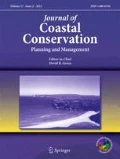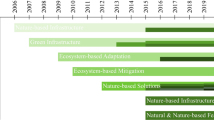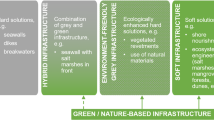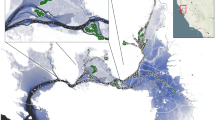Abstract
Dredged material resulting from deepening and maintenance activities of the Aveiro Harbor inlet channel, northwestern coast of Portugal, has been used to mitigate the erosion trend recorded on nearby beaches (from Barra to Costa Nova Beach) through direct placement of sand by using standard dredge equipment. The disposal activities of dredged material have been undertaken at two main sites: between the south breakwater and the 1st groin of Costa Nova (dumping area 1, DA1) and between the 3rd and the 5th groin of Costa Nova (dumping area 2, DA2).The sand was placed in the nearshore, between the −2 and −7 m Chart Datum, CD, contours.
In this study, short- and long-term coastal morphologic changes in the sea bottom, in response to several nourishment operations and to the incoming waves, within the dumping area boundaries are investigated based on a data set of hydrographic surveys collected annually, just before and after the nourishments, between 2009 and 2015. Preliminary results describing the main morphologic changes, evolution trends, sediment budget variations, and nourishments performance are discussed using mainly Geographic Information System techniques. Overall, the analysis demonstrates that the short-term losses in the dumping areas (one month of interval) can reach 50% of the nourished volume, revealing a significant movement of the fill material towards offshore. Seasonal variations promoting cross-shore material exchange can also prevail and misrepresent the sediment balances, if the monitoring area is not comprehensive. Furthermore, some bathymetric analysis suggested that longshore transport gradients have moved the fill material from Barra beach to downdrift areas. All the obtained results contribute to the ongoing discussion about the effectiveness of nearshore sand placements especially in context of an energetic environment.













Similar content being viewed by others
References
APA (2012). Relatório de Monitorização da Evolução Sedimentar e Batimétrica na Campanha de Monitorização Ambiental no Âmbito do Projecto “Dragagem da Barra com Reforço do Cordão Dunar”, 20 p (in Portuguese)
APA (2013). Relatório de Acompanhamento Ambiental. Empreitada de Reconfiguração da Barra do Porto de Aveiro, Novembro de 2012, 9 p (in Portuguese)
APAmbiente (2014). Nota técnica e esclarecimentos relativos à alimentação artificial das praias da Caparica, 2 p (in Portuguese)
Coelho C (2005). Riscos de Exposição de Frentes Urbanas para Diferentes Intervenções de Defesa Costeira. PhD thesis, Universidade of Aveiro, 405 p (in Portuguese)
Coelho C, Conceicão T, Ribeiro B (2009a) Coastal erosion due to anthropogenic impacts on sediment transport in Douro River—Portugal. Proceedings of coastal dynamics, impacts of human activities on dynamic coastal processes, paper n. 72
Coelho C, Silva R, Veloso-Gomes F, Taveira-Pinto F (2009b) Potential impacts of climate change on NW Portuguese coastal zones. ICES J Mar Sci 66:1497–1507. doi:10.1093/icesjms/fsp132
Coelho, C., Silva, P., Pinheiro, L., Gonçalves, D., (2011a). Dragagens: fundamentos, técnicas e impactos, Universidade de Aveiro, 279 p (in Portuguese). ISBN: 978–972–789-346-1
Coelho, C., Silva, R., Veloso-Gomes, F., Rodrigues, L., (2011b). Artificial Nourishment and Sand By-Passing in the Aveiro Inlet, Portugal. Proceedings of the International Conference on Coastal Engineering (Shanghai, China), Paper No. 32. doi:10.9753/icce.v32.sediment.99
Costa S, Coelho C (2013) Northwest Coast of Portugal – Past behavior and future coastal defense options. J Coast Res 65:921–926. doi:10.2112/SI65-156.1
Di Risio M, Lisi I, Beltrami G, De Girolamo P (2010) Physical modeling of the cross-shore short-term evolution of protected and unprotected beach nourishments. Ocean Eng 37:777–789. doi:10.1016/j.oceaneng.2010.02.008
Gravens M, Ebersole B, Walton T, Wise R (2003) Beach Fill Design. In: Coastal Engineering Manual, Part V: Coastal Project Planning and Design, Chapter 4. Army Corps of Engineers, Washington, DC, U.S., 113 p
IH (2015). Instituto Hidrográfico. http://www.hidrografico.pt. Last visualization in 30th July 2015
Jacobsen N, Fredsoe J (2014) Cross-shore Redistribution of Nourished Sand near a Breaker Bar. J Waterw Port Coast Ocean Eng 140(2):125–134. doi:10.1061/(ASCE)WW.1943-5460.0000233
Larson M, Hanson H (2015) Model of the evolution of mounds placed in the nearshore. J Integr Coast Zone Manag 15(1):21–33
Palalane J, Fredriksson C, Marinho B, Larson M, Hanson H (2016) Simulating cross-shore material exchange at decadal scale. Model application. Coast Eng 116:57–66. doi:10.1016/j.coastaleng.2016.05.007
Pereira C, Coelho C, Ribeiro A, Fortunato A, Lopes C, Dias J (2013) Numerical modelling of shoreline evolution in the Aveiro coast, Portugal – climate change scenarios. J Coast Res 65:2161–2166. doi:10.2112/SI65-365.1
Pinto, C., Silveira, T. and Taborda, R. (2015). Alimentação artificial das praias da Costa de Caparica: síntese dos resultados de monitorização (2007 a 2014). 3ª Conferência sobre morfodinâmica estuarina e costeira, Universidade do Algarve, 14–15 Maio
Pires HNO (1989). Alguns Aspectos do Clima de Agitação Marítima de Interesse para a Navegação na Costa de Portugal., Clima de Portugal, Fascículo XXXVII, vol. 2, Instituto Nacional de Meteorologia e Geofísica (INMG), Lisboa, Portugal, 34 p
Ruessink B, Terwindt J (2000) The behaviour of nearshore bars on the time scale of years: a conceptual model. Mar Geol 163:289–302
Schipper M, Vries S, Ruessink G, Zeeuw R, Rutten J, Gelder-Maas G, Stieve M (2016) Initial spreading of a mega feeder nourishment: Observations of the Sand Engine pilot project. J Coast Eng 111:23–38. doi:10.1016/j.coastaleng.2015.10.011
SNIRL (2015). Sistema Nacional de Informação dos Recursos do Litoral. http://geo.snirh.pt/snirlit/site/. Last visualization in 30th July 2015
Veloso-Gomes F, Taveira-Pinto F, das Neves L, Pais-Barbosa J (2006) EUrosion – A European Initiative for Suistainable Coastal Erosion. IHRH, Porto, Portugal, p 317 (in Portuguese)
Verhagen HJ (1996) Analysis of Beach Nourishment Schemes. J Coast Res 12(1):179–185 Fort Lauderdale (Florida), ISSN 0749-0208
Yates M, Guza R, O’Reilly W, Seymour R (2009) Seasonal persistence of a small southern California beach fill. Coast Eng 56:559–564. doi:10.1016/j.coastaleng.2008.11.004
Author information
Authors and Affiliations
Corresponding author
Rights and permissions
About this article
Cite this article
Marinho, B., Coelho, C., Larson, M. et al. Short- and long-term responses of nourishments: Barra-Vagueira coastal stretch, Portugal. J Coast Conserv 22, 475–489 (2018). https://doi.org/10.1007/s11852-017-0533-5
Received:
Revised:
Accepted:
Published:
Issue Date:
DOI: https://doi.org/10.1007/s11852-017-0533-5




